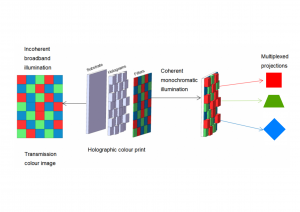The utilization of filters in AR/MR/VR fields has evolved into various innovative applications, showcasing the transformative potential of holographic filters. This article explores some of the groundbreaking uses of filters, specifically focusing on holographic technology to enhance realism and immersion in virtual environments.
Holographic filters, acting as optical elements, manipulate light in intricate ways, paving the way for highly realistic virtual objects with three-dimensional qualities. These filters address optical challenges in AR/MR/VR, such as expanding the field of view, reducing device size and weight, and enhancing overall image quality.
In addition to typical holographic filter applications, Shanghai Optics explores unconventional uses, such as creating holographic metasurfaces. These planar arrays manipulate light amplitude, phase, and polarization, allowing for advanced applications like sub-diffraction-limited focusing and complex light wave patterns.

AR, VR, and MR technologies have revolutionized engagement, with optics and display technologies playing a crucial role in their development. The market is dynamic, driven by large IT companies and innovative entrepreneurs contributing to its growth.
The pandemic accelerated the adoption of AR/VR technologies, with increased usage in healthcare, education, and retail. The shift towards lightweight wearables, enhanced navigation, and safety features reflects the growing demand for immersive experiences.
VR’s impact in training, telepresence, and visualization, accelerated by the pandemic, is expected to drive sustained growth. AR/MR systems in healthcare and manufacturing, along with advancements in lens technologies, offer new opportunities for market players.
Large enterprises dominate the AR/VR market due to increased adoption across industries. However, small and medium-sized enterprises benefit from cost reduction in training, efficient repairs, and improved customer satisfaction through AR/VR technology.
Consumer applications, including gaming and entertainment, continue to lead the AR/VR market. Enterprises, healthcare, education, and defense sectors contribute to market growth, showcasing the versatility of AR/VR technologies.
Liquid Crystal Displays (LCD) currently dominate the market, offering precise visual displays. Organic Light-Emitting Diode (OLED) screens, known for low energy consumption, also contribute to providing high-resolution experiences.
The AR/MR/VR landscape continues to evolve, driven by innovative filter applications and advancements in optics and display technologies. The diverse applications and market growth indicate a promising future for immersive experiences across various industries.